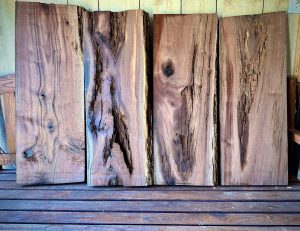Serious Hunks of Black Walnut Meet the Planer
Roughly 25 years ago, I came into possession of a cache of black walnut, thanks to a sharp-eyed reader who took note of a column announcing that I had taken up building furniture as the latest hobby. Golf no longer held its allure, though I lived on a golf course. I realized, after a decade of playing or practicing several times a week, that I was unlikely to get any better at that accursed game.
My handicap was a highly dubious 12, meaning on average I shot in the mid-80s, with help from foot wedges and a nimble scorecard pencil. I possessed no natural talent and was spending about 20 hours a week on the links – akin to having a second, part-time job, though the pay was really lousy, just winning an occasional wager with fellow hackers. I essentially quit the game except for playing in scrambles once a year or so. Now I don’t even do that and recently put my clubs up for sale on Facebook. Any left-handed golfers out there interested should take a look.
The reader of the woodworking column contacted me with an attractive offer. His barn contained a large pile of rough-cut black walnut of varying widths, lengths, and thicknesses. Come take a look and make an offer, he said. I did and came away with a trailer load for just $100. I still have about half of that stash; the other half has been transformed into furniture for us and the family.
One piece that traveled with me over the decades from Deep East Texas to the Austin area, a brief stint in Kansas and then to the shop here at Three Geese Farm, was a massive slab of black walnut – 12 feet long, 10 inches wide and 4 inches thick. It weighed well over 100 pounds. Movers across the South cursed me when transporting that hunk of wood, which I had vague plans to turn into a fireplace mantle. For the last several years, the lumber was stored at my brother-in-law Jim’s place, under a large storage trailer. I wrapped it in plastic, but the termites still found it, I learned when retrieving it after we bought the farm. The massive slab suffered the most damage, which was disheartening. I hauled it to the current shop three years ago, where it lay on the concrete floor until a few weeks ago.
That is when I decided to cut the slab into four pieces, each 30 inches long. My plan is to turn each piece into some type of end table or vanity, all equipped with metal or stone legs  as a base. On an early fall afternoon, I got off work and headed down to crank up the planer. Small creatures dove deeper into the woods to escape the noise. Pancho the Donkey began braying in protest. The dogs hid under the couch, hearing the banshee-like screams of the planer from 100 yards away. This is loud, messy work.
as a base. On an early fall afternoon, I got off work and headed down to crank up the planer. Small creatures dove deeper into the woods to escape the noise. Pancho the Donkey began braying in protest. The dogs hid under the couch, hearing the banshee-like screams of the planer from 100 yards away. This is loud, messy work.
Planing lumber is easily my least-favorite aspect of woodworking. As noted, it is ridiculously loud, even while wearing earmuffs. Wood chips fly about. Soon I am covered in dust, mingling with my sweat on this St. Martin’s summer day (The preferred term in 2024, according to our friend Google). The four slab pieces required a few dozen passes through the planer to knock off much of the termite damage. Those little buggers had chewed their way down about a half inch of the 4-inch board. I had an inkling that this might turn out nicely, as the planer exposed the grain of the wood, and the indentation caused by the termites.
As you can see by the accompanying photo, the damage caused by the termites resulted in compelling patterns on the planed – and now smooth – surface. Black walnut is a gorgeous wood with a purple hue and distinctive grain. It was worth an hour or so of nasty planing work to get to this, from which I can make some cool stuff. All that is required now is several hours of sanding and finishing.
My Beautiful Mystery Companion has first dibs on which of these four pieces will become the top for the vanity I am building for her. It will be ridiculously heavy and sturdy, which is consistent with most pieces I build. Now I just have to figure out what to create with the remaining pieces of the slab. Maybe the World’s Heaviest End Tables?
Leave a reply
Fields marked with * are required











